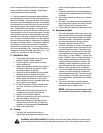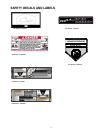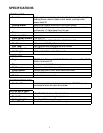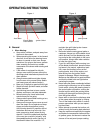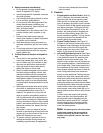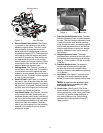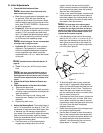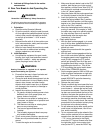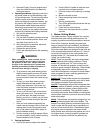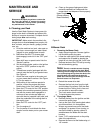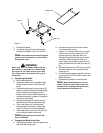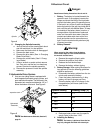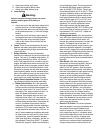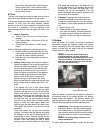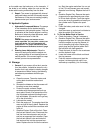15
bar forward more than the left side. NOTE:
If one lap bar is in the neutral position and
the other is advanced, the turn side tire will
not rotate and a “pivot turn” will be exe
-
cuted — turf defacement could occur (if on
grass) as well as potential damages to the
traction surface and the tire. If the lap bar
on the turn side is not brought all the way to
neutral, then the turn side tire will continue
to rotate and a “U-turn” will be executed
with a low potential for turf defacement as
well as traction surface and tire damage.
i. To drive in the REVERSE direction:
1. Make sure no bystanders, animals, or
objects are behind the machine. Look
behind the machine, and use extreme care.
2. Slowly, move both lap bars toward the rear
of the machine until the machine begins to
move rearward. Release the lap bars and
the machine should stop. The more the lap
bars are moved toward the rear of the
machine, the faster the machine will move
in the reverse direction. Release the lap
bars and the machine should stop traveling
in reverse (this is a safety check, the nor
-
mal procedure is for the operator to slowly
bring the lap bars to the neutral position).
3. Do not move the lap bars rapidly as this
could cause turf defacement and/or loss of
traction.
4. To turn, move one lap bar ahead of the
other and the machine will turn toward the
same side that was moved — I.E., to turn
counter-clockwise (to the LEFT), move the
LEFT lap bar rearward more than the right
side, and to turn clockwise (to the RIGHT),
move the RIGHT lap bar rearward more
than the left side. NOTE: If one lap bar is in
the neutral position and the other is moved,
the turn side tire will not rotate and a “pivot
turn” will be executed. Turf defacement
could occur (if on grass) as well as poten
-
tial damages to the traction surface and the
tire. If the lap bar on the turn side is not
brought all the way to neutral, then the turn
side tire will continue to rotate and a “U-
turn” will be executed with a low potential
for turf defacement as well as traction sur
-
face and tire damage.
j. To perform a “zero turn”:
1. Please note, a zero turn maneuver can not
be executed while the machine is moving in
the forward or, reverse directions, the
machine must come to a stop first.
2. To turn clockwise, slowly move the LEFT
lap bar forward while simultaneously mov
-
ing the RIGHT lap bar rearward. Release
both lap bars and the machine should stop
turning.
3. To turn counter-clockwise, slowly move the
RIGHT lap bar forward while simulta
-
neously moving the LEFT lap bar rearward.
Release both lap bars and the machine
should stop turning (this is a safety check,
the normal procedure is for the operator to
slowly bring the lap bars to the neutral posi
-
tion).
Note: If low traction conditions occur, follow
these procedures for “zero turns”:
To turn clockwise (front of machine moves toward RIGHT)
when traveling FORWARD:
1. Come to a stop,
2. Then slowly move both lap bars rearward (no more
than 1/2 maximum reverse speed) to initiate REVERSE
travel,
3. Then slowly move the LEFT lap bar forward while
maintaining the RIGHT lap bar in the rearward travel
position.
4. To stop the turn and reintiate FORWARD travel,
slowly move the RIGHT lap bar from the REVERSE
travel position to a FORWARD travel position equal to
that of the LEFT lap bar.
5. Alternatively, release both lap bars and the machine
should stop turning, (this is a safety check, the normal
procedure is for the operator to slowly bring the lap bars
to the Neutral psoition).
To turn counter-clockwise (front of machine moves toward
LEFT) when traveling FORWARD:
1. Come to a stop,
2. Then slowly move both lap bars rearward (no more
than 1/2 maximum reverse speed) to initiate REVERSE
travel,
3. Then slowly move the RIGHT lap bar forward while
maintaining the LEFT lap bar in the rearward travel
position.
4. To stop the turn and reintiate FORWARD travel,
slowly move the LEFT lap bar from the REVERSE travel
position to a FORWARD travel position equal to that of
the RIGHT lap bar.
5. Alternatively, release both lap bars and the machine
should stop turning, (this is a safety check, the normal
procedure is for the operator to slowly bring the lap bars
to the Neutral psoition).
3. Start the Engine:
a. Open the fuel shutoff valve.
b. Sit on the Seat. Set the parking brake “On”.
c. Move the left and right steering levers to the
neutral position.
d. Turn the electric blade clutch switch “Off”.
e. Push the choke/throttle control to the full for-
ward position.
f. Insert the key in the ignition and start switch
and turn the switch to “On”.
g. Turn the ignition key in a clockwise direction
to the “Start” position until the engine starts.
Note: Do not hold the key in the “Start” posi-
tion for more than 10 seconds or you may dam-
age the starter. If the engine does not start in this
time, wait about 30 seconds and try again.



